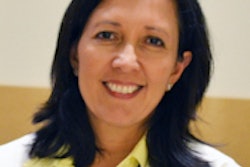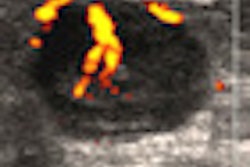Automated breast ultrasound (ABUS) shows promise as a cost-effective adjunct screening modality compared to MRI for women who have dense breast tissue at mammography, according to a study published this month in the Journal of Diagnostic Medical Sonography.
Automated breast sonography is cleared for diagnostic use in the U.S. as an adjunct to mammography. But the technology is not yet specifically cleared for screening use in women with dense breasts -- although the U.S. Food and Drug Administration recommended that it be approved for this purpose in April.
Researchers at Nova Southeastern University in Winter Springs, FL, conducted a pilot study that compared the performance of ABUS to MRI in detecting histologically proven breast lesions among asymptomatic women with dense breast tissue. They found comparable diagnostic reliability between the two modalities.
"One of the significant limitations of screening mammography is breast density, which can obscure small masses," wrote study authors Drs. Vincenzo Giuliano and Concetta Giuliano. "[ABUS] is an FDA-approved diagnostic imaging technology that is less affected by breast density. Multiple white paper studies ... show significant improvement in breast cancer detection rates when automated breast sonography is performed in addition to a digital mammogram, as part of annual routine breast cancer screening, in women with increased breast density" (JDMS, July/August 2012, Vol. 28:4, pp. 159-165).
The current study included 24 asymptomatic women with more than 50% breast density on digital mammography. Each woman received an automated breast sonography exam using the U-Systems SomoVu device equipped with a 10-MHz transducer. ABUS exams were then compared with a contrast breast MRI, which was performed within a week of the ABUS exams. All cancers that were found and classified as BI-RADS 4 or 5 were biopsied, the team wrote. The study identified 15 malignant tumors and nine benign pathologies.
The researchers used the kappa measure to compare the two modalities' diagnostic reliability (kappa is a chance-adjusted measure of agreement; values can range from -1.0 to 1.0, and a kappa value of 0.70 or above indicates adequate interrater agreement). They found comparable diagnostic reliability (kappa values between 0.95 and 0.98) between ABUS and breast MRI in differentiating benign from malignant breast lesions based on similar morphologic criteria (such as irregular shape and margins, nonparallel orientation, and hypoechoic halo).
The research team acknowledged that ABUS has some limitations, including the inability to perform compression or elastography, lack of color or spectral Doppler capability for tissue or lesion vascularity, and a limited ability to evaluate the axilla. But MRI has limitations as well, the researchers stated: Although breast MRI does well in finding cancers in dense breast tissue, it is costly and carries some risk from the required contrast media -- and is less specific as compared with mammography, thus opening the possibility of more recalls.
And the researchers noted that ABUS does offer practical advantages for large screening populations, including short examination times, simplicity of use, less technical training, less user variability, application for potential screening of large numbers of patients with dense breast parenchyma, and volumetric data with multiplanar capability. And it's less invasive for patients.
"Automated breast sonography is an attractive supplement to mammography because it is well-tolerated by patients and is relatively inexpensive," the team concluded. "Our study offers a platform for further research in using the automated breast sonography procedure as part of a larger study of asymptomatic patients with mammographically dense breasts."




















